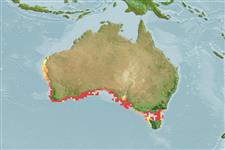>
Syngnathiformes (Pipefishes and seahorses) >
Syngnathidae (Pipefishes and seahorses) > Syngnathinae
Etymology: Hippocampus: Greek, ippos = horse + Greek,kampe = curvature (Ref. 45335).
More on author: Peters.
Environment: milieu / climate zone / rango de profundidad / distribution range
Ecología
marino demersal; no migratorio; rango de profundidad 0 - 15 m (Ref. 52034). Temperate; 21°S - 43°S
Indo-Pacific: endemic to south west Australia.
Length at first maturity / Tamaño / Peso / Age
Madurez: Lm 4.6 range ? - ? cm
Max length : 15.0 cm TL macho / no sexado; (Ref. 9002); common length : 12.0 cm TL macho / no sexado; (Ref. 9002)
Short description
Claves de identificación | Morfología | Morfometría
Espinas dorsales (total) : 0; Radios blandos dorsales (total) : 19 - 23; Espinas anales: 0; Radios blandos anales: 4.
Body shape (shape guide): other.
Adults inhabit inshore waters (Ref. 7300). Occur in small to large aggregations in weed patches attached to rocks on sand, mostly in Sargassum weeds (Ref. 9002). Ovoviviparous (Ref. 205). The male carries the eggs in a brood pouch which is found under the tail (Ref. 205). Minimum depth reported taken from Ref. 128812.
Male incubates the eggs in a pouch. Produces 50 to 100 young in single or combined brood from several females (Ref. 9002).
Lourie, S.A., R.A. Pollom and S.J. Foster, 2016. A global revision of the seahorses Hippocampus Rafinesque 1810 (Actinopterygii: Syngnathiformes): taxonomy and biogeography with recommendations for further research. Zootaxa 4146(1):1-66. (Ref. 115213)
IUCN Red List Status (Ref. 130435: Version 2024-2)
Threat to humans
Harmless
Human uses
Pesquerías: sin interés
Herramientas
Special reports
Download XML
Fuentes de Internet
Estimates based on models
Preferred temperature (Referencia
123201): 15 - 18.4, mean 16.9 °C (based on 188 cells).
Phylogenetic diversity index (Referencia
82804): PD
50 = 0.5000 [Uniqueness, from 0.5 = low to 2.0 = high].
Bayesian length-weight: a=0.00447 (0.00175 - 0.01142), b=2.99 (2.77 - 3.21), in cm total length, based on LWR estimates for this (Sub)family-body shape (Ref.
93245).
Nivel trófico (Referencia
69278): 3.5 ±0.48 se; based on food items.
Resiliencia (Referencia
120179): Medio, población duplicada en un tiempo mínimo de 1.4-4.4 años (Fec=50-100).
Fishing Vulnerability (Ref.
59153): Low vulnerability (10 of 100).
🛈
